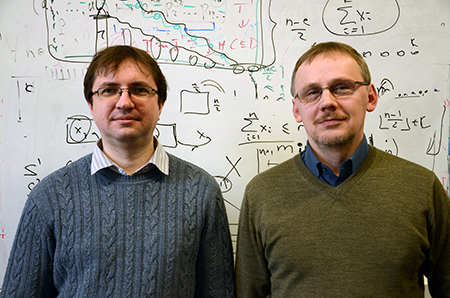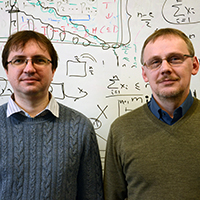Maths problem solved but it’s impossible to check
 Dr Boris Konev and Dr Alexei Lisitsa are now running software in an attempt to find a result for discrepancy 3
Dr Boris Konev and Dr Alexei Lisitsa are now running software in an attempt to find a result for discrepancy 3
University of Liverpool academics made significant progress towards solving an 80 year old maths puzzle using a computer programme, but the resulting proof is so massive it’s impossible for any human to check.
Computer scientists, Dr Boris Konev and Dr Alexei Lisitsa successfully cracked Erdős discrepancy problem (for a particular discrepancy bound C=2) and in the process produced more data than the entire written contents of Wikipedia.
Infinite sequence
The riddle was proposed in the 1930s by the Hungarian mathematician Paul Erdős, who offered $500 for its solution.
Erdős was fascinated by the extent to which an infinite sequence of numbers containing nothing but +1s and -1s contains internal patterns. One way to measure that is to cut the infinite sequence off at a certain point, and then create finite sub-sequences within that part of the sequence, such as considering only every third number or every fourth.
[callout title= ]"It is true that our computer-generated solution is beyond the reach of humans to fully understand, but it does not mean that a human-comprehensible solution could not (or will not) be found in the future"[/callout]Adding up the numbers in a sub-sequence gives a figure called the discrepancy, which acts as a measure of the structure of the sub-sequence and in turn the infinite sequence, as compared with a uniform ideal.
Dr Konev and Dr Lisitsa took a sequence 1,161 numbers long and managed to demonstrate that an infinite sequence will always have a discrepancy larger than two. The resulting proof generated is an enormous 13 gigabytes.
The pair compared this to the size of Wikipedia, the text of which is a 10-gigabyte download. It is probably the longest proof ever and dwarfs another famously huge proof, the Classification Theorem of Finite Groups, which totalled 15,000 pages.
But, although checking this is beyond the reach of humans, they suggest future developments could change the landscape.
Dr Lisitsa, from the University’s School of Electrical Engineering, Electronics and Computer Science, said: "On the one hand, it is true that our computer-generated solution is beyond the reach of humans to fully understand. On the other, all we can say for now is that at the moment there is no known ‘better’ human-comprehensible solution – but it does not mean that such a solution could not (or will not) be found in the future."
Spot a pattern
Dr Konev added: "Erdős' hypothesis was that a discrepancy of any value can always be found, a far cry from the discrepancies of 1 and 2 that have now been proven. Our software has been running for weeks in an attempt to find a result for discrepancy 3. But even if subsequent programs show that higher and higher discrepancies exist for any infinite sequence, a computer cannot check the infinity of all numbers."
Instead, Dr Lisitsa suggests, it is likely that computer-assisted proofs for specific discrepancies will eventually enable a human to spot a pattern and come up with a proof for all numbers.
[callout title=More]VIDEO – Lego Rovers head to NASA’s International Space Apps Challenge[/callout]
